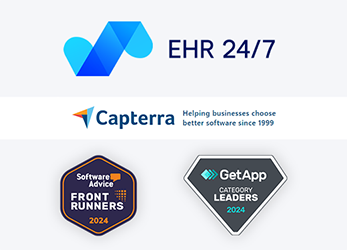Electronic Health Record Security Best Practices

It's vital to keep your practice's electronic health record (EHR) system secure. EHR security helps protect patient information and comply with privacy laws. The healthcare industry relies heavily on digital solutions. That is why robust security measures are essential. Below, we'll outline key security strategies for healthcare providers. We'll discuss how to safeguard your EHR data and meet legal standards. We'll also examine how to maintain patient trust in an ever-evolving digital landscape.
Comply with HIPAA & HITECH
Adherence to HIPAA and HITECH regulations is essential for maintaining patient confidentiality. Ensuring your practice aligns with these laws can help you protect patient data. By regularly assessing your security measures, you can identify and address potential vulnerabilities.
You should continually educate your staff on compliance standards through ongoing training programs. You should also emphasize the importance of data protection in their daily workflows so that everyone is aligned with your security goals. You will also want to put in place strict access controls, limiting data access to authorized personnel only.
Using robust encryption methods for both stored and transmitted data will help you create a strong defense against unauthorized access. By prioritizing compliance, you can protect patient privacy. You can also shield your practice from potential legal and financial repercussions.
Train Staff to Follow Official EHR Access Processes
Comprehensive staff training is crucial for maintaining EHR security. Developing a clear, official process for accessing electronic health records can help ensure all employees are partners in your goal of protecting patient data.
This can be done by conducting regular training sessions that cover proper login procedures and data handling protocols. You should emphasize the importance of maintaining patient confidentiality and include real-world scenarios to help staff recognize potential security risks.
If you implement a system of accountability, each staff member will feel responsible for their own login credentials. Encourage a culture of security awareness. Employees must feel comfortable reporting suspicious activities or potential breaches. Regular refresher courses can help keep security protocols top-of-mind. They can also address any emerging threats or updated procedures.
Password Protection for Electronic Records
As with any system, secure passwords are crucial for EHR security. When you enforce strong password requirements you prevent unauthorized access and protect sensitive patient data.
Implement a policy mandating complex passwords with a mix of characters. Require regular updates, typically every 60 to 90 days. Consider using password management tools to help staff maintain unique, strong passwords.
Educate staff on password security risks and best practices. Encourage using password phrases that are memorable but hard to guess. This creates a robust first line of defense for your EHR system.
Leverage Multifactor Authentication Method
Multifactor authentication (MFA) adds a crucial layer of security to your EHR system. MFA significantly reduces the risk of unauthorized access, even if passwords are compromised.
Implementing MFA for all user accounts requires two or more verification factors from these three categories:
- Something the user knows (a password or security question)
- Something they have (a smartphone app or security token)
- Something they are (biometrics)
This approach creates multiple barriers for potential intruders.
You should educate your staff on the importance of MFA to ensure they understand how to use it correctly. Regularly review and update your MFA protocols. This allows you to address emerging security threats and technological advancements.
Set Up Automated Alerts
Implementing automated alerts is another proactive approach to EHR security. Alerts can quickly notify administrators of potential security breaches or unusual system activities.
If you configure your EHR system to trigger alerts for repeated failed login attempts, it may indicate a brute-force attack. Another good tip is to set up notifications for sudden access to large volumes of data, which could be a signal for unauthorized bulk data retrieval or potential insider threats.
Establish a clear protocol for responding to these alerts. It should include immediate steps to investigate and mitigate potential risks. You should also regularly review and adjust alert thresholds to minimize false positives while ensuring genuine threats are caught. This vigilant monitoring helps maintain the integrity of your EHR system. It also protects sensitive patient information and safeguards trust.
Reduce Risk Associated with Interoperability
While interoperability enhances healthcare delivery, it also introduces security risks. To mitigate these risks, implement strong data exchange protocols. Additionally, you should have encryption methods for all shared information.
By carefully vetting and monitoring third-party systems that connect to your EHR, you can ensure these systems also meet your security standards. You should implement strict access controls because external systems should only have the minimum necessary access to function effectively.
It is important to regularly audit data-sharing practices and update your security measures. Training staff on proper procedures for sharing patient data securely can help you maintain the integrity of your EHR system and balance the benefits of interoperability with robust security measures. It can also allow you to improve patient care through seamless information exchange.
Conduct Regular Security Audits to Determine Areas of Weakness
A regular security audit can be crucial for identifying vulnerabilities in your EHR system. Consider scheduling a comprehensive audit at least annually and possibly more frequently for critical components.
These audits should assess all aspects of your EHR security. They should include user access controls, data encryption, network security, and physical safeguards. If you use both internal and external auditors, you can get a more diverse perspective on your security posture.
Act promptly on audit findings, prioritizing high-risk vulnerabilities. Develop and implement a remediation plan for each identified weakness. Regular audits help maintain robust security and demonstrate your commitment to protecting patient data. They're essential for regulatory compliance and maintaining patient trust.
Encrypted Data
Encrypting data, both stored and transmitted, is a crucial security measure for EHR. It ensures that even if data is intercepted, it cannot be read or used. Encryption is a critical line of defense. It protects patient information against breaches and cyber threats.
You should implement strong encryption protocols for all patient data at rest and in transit and use industry-standard encryption algorithms. Make sure to keep encryption keys secure and separate from the encrypted data. Then, regularly update your encryption methods to stay ahead of emerging threats.
Also, ensure that all devices accessing the EHR system, including mobile devices, use encryption. You may also want to train your staff on the importance of encryption. It is important that they understand how to properly handle encrypted data to maintain its integrity.
Access Logs
Access logs can track who views or modifies electronic health records. These logs help monitor unauthorized or suspicious activity, providing a clear audit trail. This oversight can be instrumental in maintaining the integrity and confidentiality of your patient data.
When you implement comprehensive logging processes within the EHR system, you can capture user identities, access times, and specific actions performed. Regularly reviewing these logs helps identify unusual patterns or potential security breaches.
You can also set up automated alerts for suspicious activities. Include red flags like after-hours access or bulk data downloads. Ensuring logs are securely stored and protected from tampering and maintaining them for an appropriate duration can help you comply with regulatory requirements and support potential investigations.
Establish Robust Access Controls
Strong access controls are fundamental to EHR security. Adopting the principle of least privilege means you grant users the least amount of access needed for their roles.
Role-based access control (RBAC) can streamline permissions management. You should regularly review and update user access rights, especially when staff roles change often. Also, if you implement automatic logoff after periods of inactivity, you can help prevent unauthorized access on unattended devices.
Robust access controls significantly reduce the risk of unauthorized data access and potential breaches.
ONC-ATCB Certification
When choosing an electronic health records (EHR) software, you may want to make sure it adheres to fundamental security and operational standards of ONC-ATCB certification is vital to EHR security. This certification demonstrates a system's effectiveness in protecting patient data. It also demonstrates the ability to follow necessary regulations and guidelines.
ONC-ATCB certified EHR systems undergo rigorous testing for functionality, interoperability, and security. They meet the criteria set by the Office of the National Coordinator for Health Information Technology. This certification helps streamline the implementation process and reduces the risk of non-compliance.
You may also want to regularly check for updates or recertifications to ensure ongoing compliance. This proactive approach safeguards patient data. This will support your practice's commitment to the highest standards of health information technology.
Regular Software Updates and Patch Management
It’s important that your EHR software regularly install updates and patches to protect against new cyber threats. Up-to-date software helps healthcare providers close security gaps and enhance system defenses. It can also help ensure patient data remains protected against evolving cybersecurity risks.
If you are in charge of installing your own updates and patches, you should establish a systematic approach to implementing these. You can create a schedule for regular system checks and implement automated update notifications. First, prioritize critical security patches. Then, test updates in a controlled environment before full deployment.
Educate staff on the importance of timely updates. They should also understand the potential risks of postponing them. Develop a policy that outlines update procedures and designates responsible personnel. Regularly review and adjust your update strategy. It should address emerging threats and changing system requirements.
If you're using a web-based EHR system like Office Ally, software updates and security patches are typically automatic. This means you don’t have to worry about manually installing updates or monitoring for critical security fixes. However, it’s still important to stay informed about any system changes, as updates can impact workflows or introduce new features. Regularly review update notifications and train staff on any modifications to help ensure a smooth transition.
Integrate Cybersecurity Framework
Consider adopting established frameworks like the NIST Cybersecurity Framework or HITRUST CSF. These provide structured approaches to managing cybersecurity risks. Tailor the chosen framework to your organization's specific needs and resources.
Implement continuous monitoring and assessment processes to identify potential threats and vulnerabilities. Develop incident response plans and regularly conduct drills to test their effectiveness. Ensure all staff are trained on their roles within the cybersecurity framework.
Develop a Data Loss Prevention Plan
A data loss prevention plan can be essential for minimizing the risk of data breaches. This type of plan outlines strategies to protect patient data and defines how to detect leaks and respond effectively.
You may want to use data loss prevention software to categorize information based on sensitivity. It can also monitor and control data movement across networks, endpoints, and cloud services. Establishing clear policies for data handling, including data storage, transmission, and disposal, can help mitigate the effects of lost data and ensure swift action in case of a data breach or loss event.
Consistently Backup Data & Create Data Recovery Plan
Backing up data and having a strong recovery plan is vital. It ensures business continuity amid disasters or system failures. Data loss prevention focuses on protecting data from unauthorized access or breaches. By contrast, this plan centers on restoring data and operations after an incident.
Implementing a comprehensive backup strategy that automates encrypted backups of all critical EHR data and stores backups in multiple secure locations, including off-site or cloud-based storage, helps ensure your data is safe.
You should also have a detailed disaster recovery plan that outlines steps for restoring systems and data in the event of loss. You should regularly test your recovery procedures to ensure they work effectively and efficiently. Key personnel should also be trained on their roles in the recovery process. This will help minimize downtime and data loss in the event of a disaster.
Elevate Your EHR Security with Office Ally
Office Ally offers a robust EHR solution designed with these security measures in mind. Explore our solutions to elevate your practice data management and safeguard your patients' information.







.svg)

.png)








